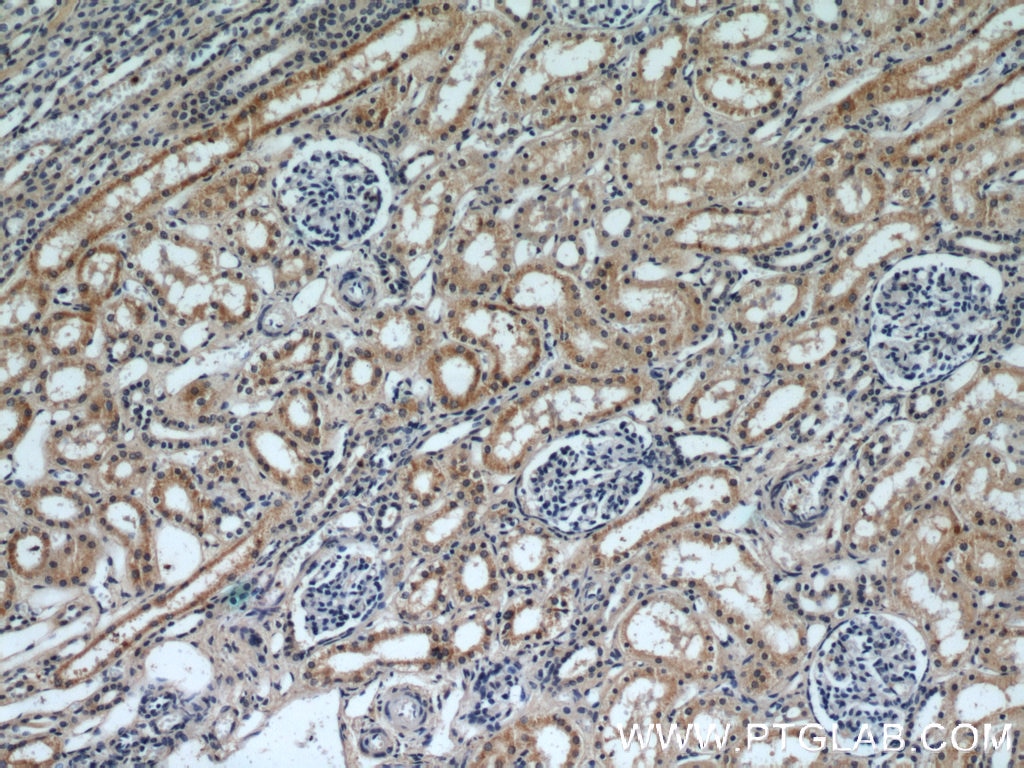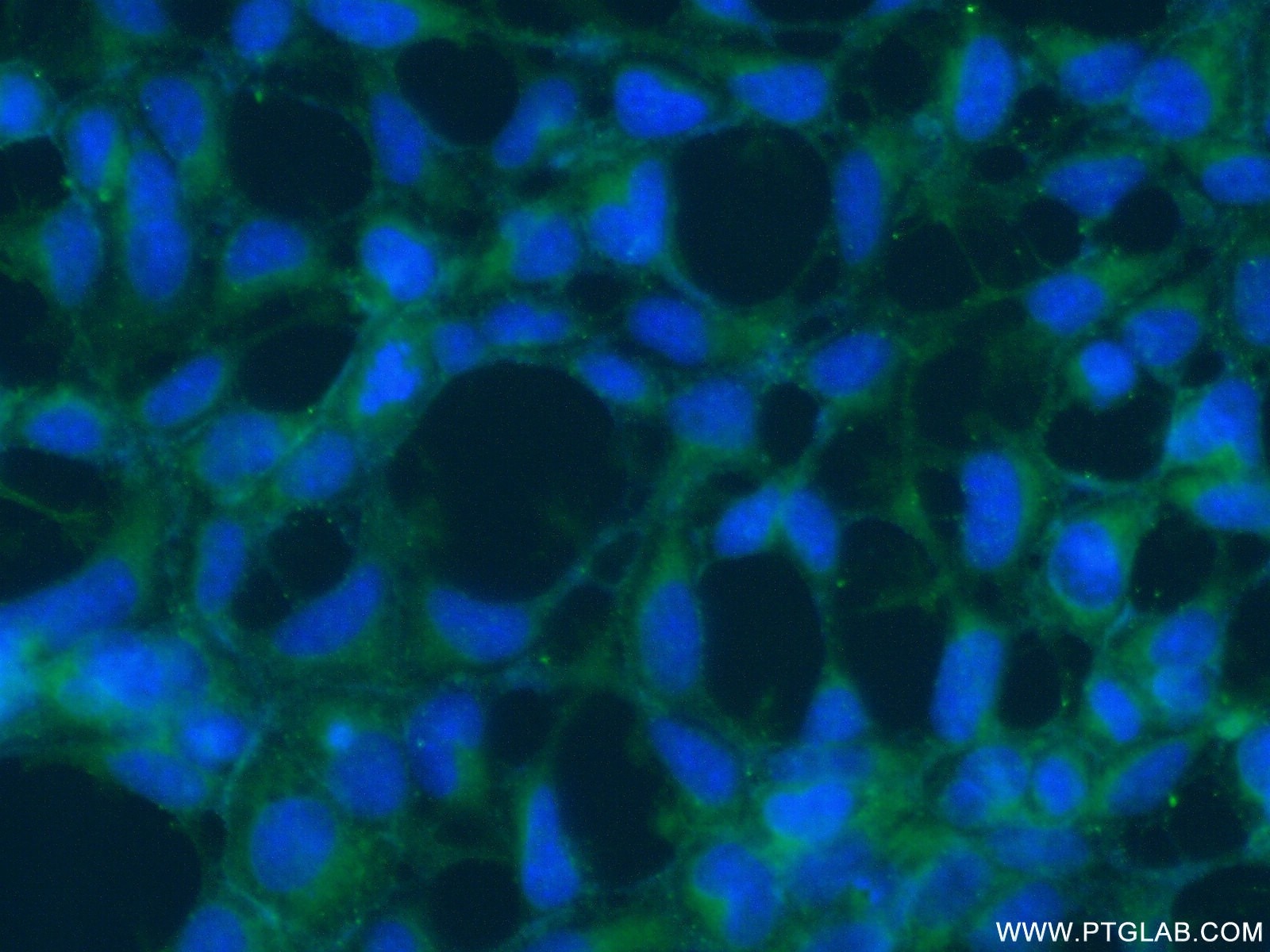Validation Data Gallery
Tested Applications
| Positive WB detected in | HEK-293 cells, mouse brain tissue |
| Positive IHC detected in | human kidney tissue, human breast cancer tissue Note: suggested antigen retrieval with TE buffer pH 9.0; (*) Alternatively, antigen retrieval may be performed with citrate buffer pH 6.0 |
| Positive IF/ICC detected in | HEK-293 cells |
Recommended dilution
| Application | Dilution |
|---|---|
| Western Blot (WB) | WB : 1:500-1:1000 |
| Immunohistochemistry (IHC) | IHC : 1:20-1:200 |
| Immunofluorescence (IF)/ICC | IF/ICC : 1:50-1:500 |
| It is recommended that this reagent should be titrated in each testing system to obtain optimal results. | |
| Sample-dependent, Check data in validation data gallery. | |
Published Applications
| KD/KO | See 3 publications below |
| WB | See 17 publications below |
| IHC | See 6 publications below |
| IF | See 5 publications below |
| ELISA | See 1 publications below |
Product Information
20217-1-AP targets SLIT2-Specific in WB, IHC, IF/ICC, ELISA applications and shows reactivity with human, mouse, rat samples.
| Tested Reactivity | human, mouse, rat |
| Cited Reactivity | human, mouse, rat |
| Host / Isotype | Rabbit / IgG |
| Class | Polyclonal |
| Type | Antibody |
| Immunogen | Peptide 相同性解析による交差性が予測される生物種 |
| Full Name | slit homolog 2 (Drosophila) |
| Calculated molecular weight | 170 kDa |
| Observed molecular weight | 130-140 kDa, 200 kDa |
| GenBank accession number | NM_004787 |
| Gene Symbol | SLIT2 |
| Gene ID (NCBI) | 9353 |
| RRID | AB_10805766 |
| Conjugate | Unconjugated |
| Form | Liquid |
| Purification Method | Antigen affinity purification |
| UNIPROT ID | O94813 |
| Storage Buffer | PBS with 0.02% sodium azide and 50% glycerol , pH 7.3 |
| Storage Conditions | Store at -20°C. Stable for one year after shipment. Aliquoting is unnecessary for -20oC storage. |
Background Information
SLIT2, also named as SLIL3, is thought to act as molecular guidance cue in cellular migration, and function appears to be mediated by interaction with roundabout homolog receptors. During neural development it is involved in axonal navigation at the ventral midline of the neural tube and projection of axons to different regions. SLIT1 and SLIT2 seem to be essential for midline guidance in the forebrain by acting as repulsive signal preventing inappropriate midline crossing by axons projecting from the olfactory bulb. In spinal chord development, SLIT2 may play a role in guiding commissural axons once they reached the floor plate by modulating the response to netrin. SLIT2 may be implicated in spinal chord midline post-crossing axon repulsion. In vitro, only commissural axons that crossed the midline responded to SLIT2. In the developing visual system it appears to function as repellent for retinal ganglion axons by providing a repulsion that directs these axons along their appropriate paths prior to, and after passage through, the optic chiasm. In vitro, it collapses and repels retinal ganglion cell growth cones. SLIT2 seems to play a role in branching and arborization of CNS sensory axons, and in neuronal cell migration. It seems to be involved in regulating leukocyte migration. The antibody is specific to SLIT2.
Protocols
| Product Specific Protocols | |
|---|---|
| WB protocol for SLIT2-Specific antibody 20217-1-AP | Download protocol |
| IHC protocol for SLIT2-Specific antibody 20217-1-AP | Download protocol |
| IF protocol for SLIT2-Specific antibody 20217-1-AP | Download protocol |
| Standard Protocols | |
|---|---|
| Click here to view our Standard Protocols |
Publications
| Species | Application | Title |
|---|---|---|
Nature Tumoural activation of TLR3-SLIT2 axis in endothelium drives metastasis.
| ||
Neuron Dendrite self-avoidance requires cell-autonomous slit/robo signaling in cerebellar purkinje cells. | ||
Angiogenesis Slit2/Robo1 signaling is involved in angiogenesis of glomerular endothelial cells exposed to a diabetic-like environment.
| ||
Front Cell Dev Biol Deletion of Mea6 in Cerebellar Granule Cells Impairs Synaptic Development and Motor Performance. | ||
J Transl Med Identification and validation of smoking-related genes in lung adenocarcinoma using an in vitro carcinogenesis model and bioinformatics analysis. | ||
Front Cell Neurosci MEA6 Deficiency Impairs Cerebellar Development and Motor Performance by Tethering Protein Trafficking. |







